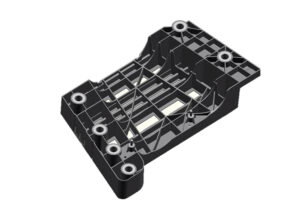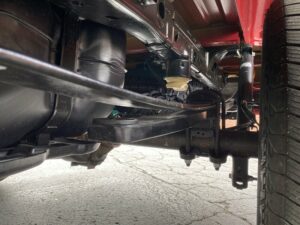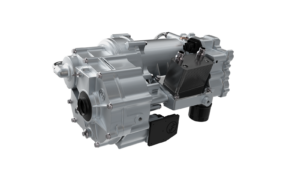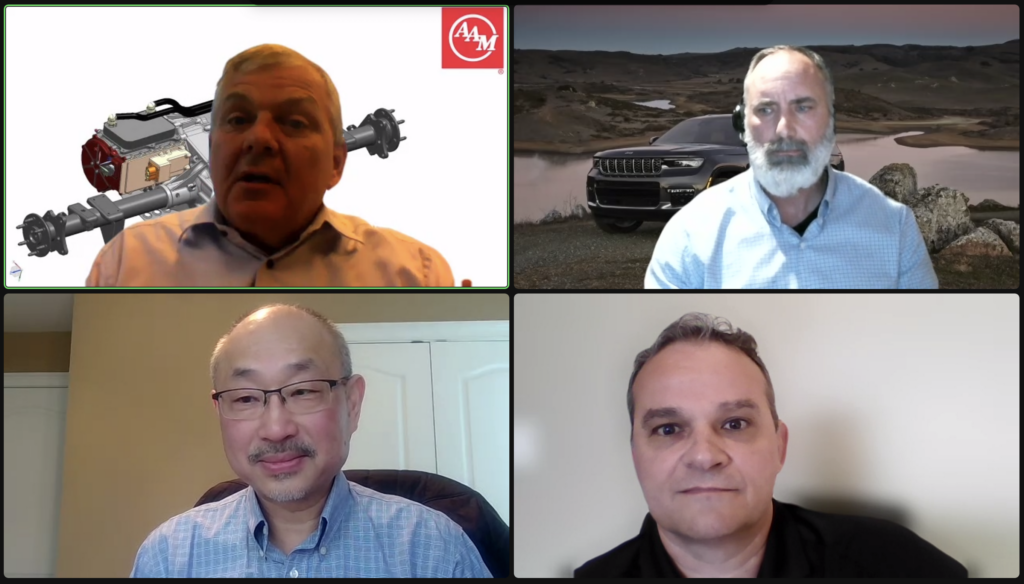
Trend of lightweighting likely to accelerate, suppliers to OEMs agree
By onMarket Trends | Technology
The need to decrease emissions and improve vehicle efficiency will accelerate lightweighting efforts by the OEMs and their suppliers, industry representatives agreed last week in a livestreamed roundtable discussion presented by the Center for Automotive Research.
Although the materials associated with lightweighting, such as composites, are more expensive on a cost-per-pound basis, suppliers are increasingly able to make the case that they offer benefits that offset that expense, participants said.
On the panel were three representatives of companies that won Altair’s 2021 Enlighten Awards: Craig Renneker, Vice President for Driveline Product Engineering at American Axle & Manufacturing (AAM); Chris Korson, Chassis Market Segment Manager, Performance Materials at BASF Corporation; and Brent Collyer, VP Engineering, R&D Director Lightweighting at Rassini International Inc.
The Altair Enlighten Award is the industry’s only award dedicated to vehicle lightweighting and sustainability.
Repairers have very likely already encountered two of the lightweight components that won Altair’s recognition: BASF, working with L&L Products, developed a composite tunnel reinforcement used in the 2021 Jeep Grand Cherokee, while Rassini developed a single-leaf steel-and-composite spring introduced in the 2021 Ford F-150 pickup.
As the technology involved in using these new materials advances, suppliers will have more and more opportunities to work with OEMs to get these lightweight components into production, panelists agreed.
They also noted that the ongoing transition to battery electric vehicles (BEVs) will probably not blunt lightweighting efforts. “The fact is that the BEVs also need to be efficient, because the energy that’s going in to power these batteries is still over 60% carbon-based fuels that are going into our electric grid,” Collyer said.
Panelists offered a behind-the-scenes look at a process in which suppliers are constantly examining current production method, and then looking at their own specialized abilities to offer the OEMs an alternative part that weighs less.
“I guess it always starts with trying to find a void in our portfolio,” Korson said. “As a market segment manager, the biggest challenge I have is I’m in a market that has a lot of potential. It’s about 15 billion pounds of material, and most of it’s metal. So we’re trying to understand different areas where we can get into and compete against ultra high-strength steel, magnesium and aluminum materials.”
In the case of the Grand Cherokee chassis reinforcement, that meant the use of pultrusion, a continuous process used to create straight or curved composite profiles reinforced with continuous fibers and mats.
“We found that we could match ultra high-strength steel and have a superior strength-to-weight ratio,” Korson said. “And that really opened the door for us to start introducing this concept to our development partners,” L&L Products.
As a privately-held company, L&L “moves pretty fast, and it’s hard for us to keep up with them at times,” he said. “But they’ve been a great development partner, and that’s what you need when you try to introduce these types of technology into the industry.”
Altair awarded BASF, L&L and Stellantis an Altair Enlighten Award in 2021 for the composite tunnel reinforcement, which is located on the underside of the vehicle and is part of the overall transmission mounting system.
In the event of a small offset or side impact collision, the reinforcement transfers the energy load from the outer rail to the transmission mount crossmember, helping to keep passengers safe. The component helped the Grand Cherokee pass the Insurance Institute for Highway Safety (IIHS) small offset rigid barrier test.
Korson said the composite part saves five pounds per vehicle over the multi-part steel component it replaces, and is used on both the standard- and long-wheelbase versions of the Grand Cherokee, simplifying production.
“There was a lot of nervousness” at BASF over the component, he said, “because there were just so many firsts going on. But I think the due diligence, the preparation that we had between companies … made sure it was ready for prime time.”
 Collyer said Rassini, the largest manufacturer in the leaf spring market, has been working with steel manufacturers on new alloys, and has tried “just about every kind of composite process that there is.” The component developed for Ford is parabolic main steel leaf supported by a composite helper.
Collyer said Rassini, the largest manufacturer in the leaf spring market, has been working with steel manufacturers on new alloys, and has tried “just about every kind of composite process that there is.” The component developed for Ford is parabolic main steel leaf supported by a composite helper.
He said Rassini’s approach is “to bring efficient solutions, new solutions to our customer, and offer a menu of choices, and let them select which option works best for their needs.”
As the properties of composites become better known, it becomes easier to consider them as alternatives to steel and aluminum, Collyer said. “I’m no longer constrained by the material properties of an isotropic material such as steel or aluminum. I have tremendous choices on resin solutions, on fiber solutions.”
He noted that Rassini is developing a composite replacement for battery pack enclosures on BEVs, which are now manufactured from metal. “We see tremendous opportunity. We have a lot of customer interest, now that we are the largest HRPTM [high pressure resin transfer molding] composite manufacturer in North America.”
Collyer said that “premium” materials like composites can be presented in a way that justifies their higher per-pound cost to OEMs.
“Just as a hypothetical, a typical pickup truck gets maybe 20 miles per gallon, something like that. And let’s say that you can take 16 kgs out of said vehicle. That’s about a half a percent fuel economy improvement.
“That doesn’t sound like a lot, right? But if you’re on a high-volume platform that, say, over the entire platform life … [produces] 2.5 million vehicles, and assume those vehicles travel on average 150,000 miles – if you do the math on it, that’s 750,000 metric tons of CO2 reduced, and over 300 million liters of fuel saved.”
“All the OEMs are committed to reducing greenhouse gases, they’re all making big claims, they’re making tremendous investments. And if you can provide a business case that makes sense, that shows how you can support their goals of reducing greenhouse gases or [increasing] sustainability, there’s value in that, even if it is a premium product,” Collyer said.
Korson agreed. “In the case of the Grand Cherokee component, we knew our raw material cost per pound was going to be more expensive” than steel, he said. “But by eliminating the secondary operations, the additional capital for the stamping tools, and using overall just less resources, we were able to put together a very attractive story.”
“I think the big picture is key, because, really, we’re trying to sell a value proposition that works for ourselves, the Tier 1, the OEM, and, ultimately, the end consumer,” he said.
 American Axle’s next generation Electric Drive Unit (eDU), an integrated high-speed electric motor and inverter package, also makes financial sense for OEMs, Renneker said.
American Axle’s next generation Electric Drive Unit (eDU), an integrated high-speed electric motor and inverter package, also makes financial sense for OEMs, Renneker said.
“I’ve been in the traditional driveline space most of my career, and we are typically talking about dollars per kilo trade off, you know, substituting material – steel for aluminum, magnesium for aluminum – and then looking at that cost per kilogram,” he said.
Though it requires a shift in thinking, electric drive units provide savings, too, he said. “The higher speed motor provides the same power with a smaller footprint. The smaller package envelope means less mass and less active material.
“We had to add a little bit of money into the cooling system to allow the motor to be smaller. But overall we saw that as a win, where the higher speed and smaller motor was lighter and less expensive at the same time,” Renneker said.
“We save about eight kilograms by integrating the inverter into the motor with no compromise on the function. So in this space, we really see an opportunity for a very rare win-win, where you can lower the cost and lower the mass at the same time,” he said.
He said AAM, which supplies the drive units used in the BEV Jaguar I-Pace, is planning to announce within the next month that it will be launching a new, two-speed axle for use by a premium European OEM.
AAM has reacted to market demands by developing its own software control capability from scratch, and learning to deal with new complexities. “It’s not uncommon for an electric drive system to have 30,000 cascaded requirements from our OE customers. And we have to show evidence that we meet every single one of those 30,000 requirements,” he said.
For AAM, the transition to electrification “has been very exciting for me. I’ve really enjoyed it. But it’s also just a matter of fundamental survival for many of us, as we see the drivelines changing from the traditional driveline that we’ve been so successful with for so many years,” Renneker said.
Altair is a global technology company providing solutions in product development, high-performance computing, and data analytics. The Altair Enlighten Award is presented annually in conjunction with the Center for Automotive Research (CAR). This year’s awards will be presented on August 2, 2022.
More information
Altair Enlighten Award website
https://www.altair.com/enlighten-award/
2021 Enlighten Award winners
https://www.sae.org/news/2021/08/2021-altair-enlighten-award-winners
Images
Featured image: The chassis reinforcement component developed for the Jeep Grand Cherokee by BASF and L&L Products. (Provided by BASF)
Participants in the CAR panel discussion included, clockwise from upper left, Craig Renneker of American Axle & Manufacturing Chris Korson of BASF, Brent Collyer of Rassini International, and moderator Richard Yen, senior vice president of Altair.
The rear leaf spring developed by Rassini. (Provided by Hexion)
AAM’s next generation electric drive unit. (Provided by AAM)

